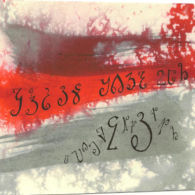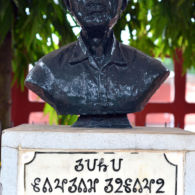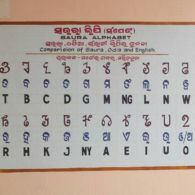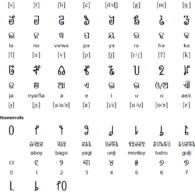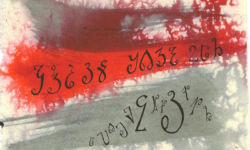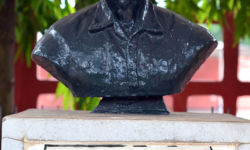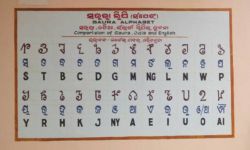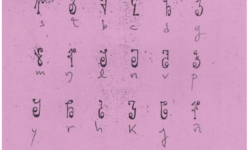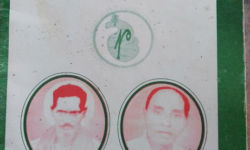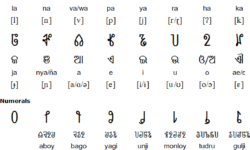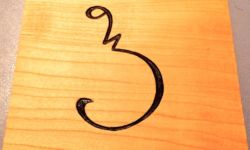Profile
Sora Sompeng, which is used to write Sora (or Savara), a language spoken by about 300,000 people mainly in Odisha and Andhra Pradesh in the east of India, is one of the world’s many visionary scripts.Visionary scripts are writing systems based on images, symbols and/or instructions, often from a deity, that appeared in a vision or dream to someone who then undertook the much more substantial and demanding task of writing them down, organizing them, and teaching them.
The fact that we know of at least twenty visionary scripts speaks to three things: how much work is involved in coming up with a system of unique and original symbols for sounds, and thus how much easier it is when they come to us in a dream; how writing speaks to us so deeply that it can even burst into our dreaming awareness; and how writing is so important and astonishing an invention that it can feel divinely inspired.
The relationship between the Sora and their script is extraordinary and possibly unique.
“In the 1970s they held what may well be the most elaborate form of communication between the living and the dead documented anywhere on earth,” writes Piers Vitebsky in his wonderful book Living Without the Dead. “Almost every day in every village, living people engaged in conversations with the dead, who would speak, one after another, through the mouth of a shaman… in trance. Together, living and dead would chat, weep, or argue for hours at a time.”
This animist tradition has been increasingly threatened during the 20th century by local Sora forms of evangelical Baptist Christianity and Hindu fundamentalism, to the point where it is now virtually extinct. The Sora Sompeng is the focus of one among several Hindu reform movements, which Vitebsky calls “alphabet worshippers.”
It’s hard to do justice in a few words to the depth and complexity of the relationship between the Sora’s particular spirituality and their particular alphabet — it’s a subject that takes Vitebsky a whole book to explain. As the story was told to him, on June 18, 1936, a Sora called Mallia “had received a dream showing him where to find a special Sora script magically inscribed on a mountaintop.”
The Sora heartland where Vitebsky lived in the 1970s was still an oral culture which held writing in awe as a great mystique, and their shamans gained their powers of trance by marrying high-caste spirits in the Underworld who were literate in the dominant Odiya (Oriya) language. Vitebsky interprets these spirit marriages as a protection against outside domination, and the alphabet cult as a different response which empowers the Sora as they acquire a writing system which (unlike the Roman letters of the Bible) is uniquely theirs.
In Mallia’s dream, each of the 24 sonums who populated and made up the Sora spirit world changed into the letter that began the sonum’s name. In her article on the creation of the Sora and other scripts of the region, Cécile Guillaume-Pey writes: “While the script is considered as the embodiment of [the god] Jagannath, it is commonly called ‘script of the spirits’ (sonum sompeng) by the adepts of Matharvanam who live in Odisha; in Andhra Pradesh, the devotees also employ the expression nyonan-lipi, which can be translated as ‘spirit-letters’.
“Around half of the 24 letters of the script are associated, according to an acrophonic principle, with a sound that corresponds to the first phoneme of a term that designates a spirit. For example, the second letter of the alphabet, /Ta/, corresponds to the spirit of the paths, Tangorsum. The consonant /Ba/ is associated to Babusum, the name given to the tutelary deity of the village, while the vowels /E/ and /I/ refer to the ancestors (elda/iday). If worshippers consider that the characters of the sacred script ‘are spirits’ (sonum/nyonan), we observe nonetheless that the ‘spirit-letters’ composing this writing system are, to say the least, a miscellaneous set. While some of them are directly associated with deities of the Sora pantheon, several characters do not exactly correspond to sonum/nyonan but to objects or spaces which can be related to them in a ritual context. Thus, the central pillar of the Sora house, soundang, where offerings are made for spirits, is represented by the first letter of the alphabet: /Sa/. In the same way, the mortar hole, on’al, gives its name to the vowel /O/. These elements are not considered as divine agents themselves but represent a contact point between the human world and that of the spirits….”
“People thought he was crazy, but `his standard of thinking was so high’ that he remained without food on that mountain for twenty-one days. His daughter married a man called Manggai, who propagated the script and turned it into a cult.”
The alphabet-worshippers, the author explains, called themselves Marirenji, meaning the Pure, Alert, or Clear-Sighted Ones. One of their songs, though sung in a format used in the older Sora ceremonies, is “a mnemonic for a sequence of alphabetical signs.”
Though this script is Sora, its main proponents, the alphabet-worshippers, use it almost entirely in oral performance, and in 2011, Vitebsky estimated, only a few hundred people could read the script at all. “Since their texts are a limited homemade corpus locked up in almost unknown symbols, one could only worship this script as a mystery rather than use it as a tool for everyday purposes: literacy without literature.”
Nevertheless, Sora Sompeng is reportedly used not only in ceremonial performance but is published in a variety of printed materials, tracts, almanacs, invitation cards, and is to some extent taught in schools.
A fascinating instructional video can be found HERE.
You can help support our research, education and advocacy work. Please consider making a donation today.
Links
General Script, Language, and Culture Resources
- Unicode
- Wikipedia
- Omniglot (PDF)
- Three Munda Scripts (PDF)
- Scriptsource
- Sorang Sompeng Learning Book
- Dialogues with the Dead: The Discussion of Mortality Among the Sora of Eastern India
- Article from LivingTongues.org
- Article about Sora Sompeng type design (PDF)
